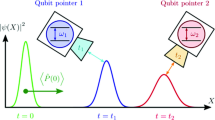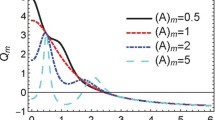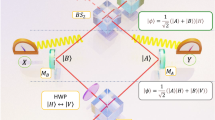Abstract
In the iconic measurements of atomic spin-1/2 or photon polarization, one employs two separate noninteracting detectors. Each detector is binary, registering the presence or absence of the atom or the photon. For measurements on a d-state particle, we recast the standard von Neumann measurement formalism by replacing the familiar pointer variable with an array of such detectors, one for each of the d possible outcomes. We show that the unitary dynamics of the pre-measurement process restricts the detector outputs to the subspace of single outcomes, so that the pointer emerges from the apparatus. We propose a physical extension of this apparatus which replaces each detector with an ancilla qubit coupled to a readout device. This explicitly separates the pointer into distinct quantum and (effectively) classical parts, and delays the quantum to classical transition. As a result, one not only recovers the collapse scenario of an ordinary apparatus, but one can also observe a superposition of the quantum pointer states.



Similar content being viewed by others
Notes
Orthodox refers in this context to the use of unitary evolution up to the point of the trace over environmental states, without the introduction of a phenomenological nonlinear interaction which would induce a collapse of the state vector.
References
von Neumann, J.: Mathematical Foundations of Quantum Mechanics (Beyer, R.T., Trans. ), pp. 437–445. Princeton University Press, Princeton (1955)
Brasil, C.A., de Castro, L.A.: Understanding the pointer states. Eur. J. Phys. 36(6), 065024 (2015)
London, F., Bauer, E.: The theory of observation in quantum mechanics. In: Wheeler, J.A., Zurek, W.H. (eds.) Quantum Theory and Measurement, pp. 217–259. Princeton University Press, Princeton (1983)
Wigner, E.P.: Remarks on the mind-body question. In: Good, I.J. (ed.) The Scientist Speculates. Heinemann, London (1961)
Everett, H.: Relative state formulation of quantum mechanics. Rev. Mod. Phys. 29, 454 (1957)
DeWitt, B.S., Graham, N.: The Many-Worlds Interpretation of Quantum Mechanics. Princeton University Press, Princeton (1973)
Jammer, M.: The Philosophy of Quantum Mechanics: The Interpretations of Quantum Mechanics in Historical Perspective. Wiley, New York (1974)
de Castro, L.A., de Sá Neto, O.P., Brasil, C.A.: An introduction to quantum measurements with an historical motivation. Acta Physica Slovaca 69, 1 (2019)
Weinberg, S.: Lectures on Quantum Mechanics. Cambridge University Press, Cambridge (2013)
Zeh, H.D.: On the interpretation of measurement in quantum theory. Found. Phys. 1, 69 (1970)
Zurek, W.H.: Pointer basis of quantum apparatus: into what mixture does the wave packet collapse? Phys. Rev. D 24, 1516 (1981)
Zurek, W.H.: Environment-induced superselection rules. Phys. Rev. D 26, 1862 (1982)
Joos, E., Zeh, H.D.: The emergence of classical properties through interaction with the environment. Zeit. Phys. B 59, 223 (1985)
Zurek, W.H.: Decoherence, Einselection, and the quantum origins of the classical. Rev. Mod. Phys. 75, 715 (2003), also see Phys. Today 44, 36 (1991)
Schlosshauer, M.: Decoherence, the measurement problem, and interpretations of quantum mechanics. Rev. Mod. Phys. 76, 1267 (2005)
Joos, E., et al.: Decoherence and the Appearance of a Classical World in Quantum Theory. Springer, Berlin (2003)
Schlosshauer, M.: The quantum-to-classical transition and decoherence. In: Aspelmeyer, M., Calarco, T., Eisern, J., Schmidt-Kaler, F. (eds.) Handbook of Quantum Information. Springer, Berlin (2014)
Lawrence, J.: Observing a quantum measurement. Found. Phys. 52, 14 (2022)
Nielsen, M.A., Chuang, I.L.: Quantum Computation and Quantum Information, p. 217. Cambridge University Press, Cambridge (2000)
Dür, W., Vidal, G., Cirac, J.I.: Three qubits can be entangled in two inequivalent ways. Phys. Rev. A 62, 062314 (2000)
Scully, M.O., Englert, B.-G., Schwinger, J.: Is spin coherence like Humpty-Dumpty? I. Simplified treatment. Found. Phys. 18, 1045 (1988)
Margalit, Y., Zhou, Z., Machluf, S., Japha, Y., Moukouri, S., Folman, R.: Analysis of a high-stability Stern-Gerlach spatial fringe interferometer. N. J. Phys. 21, 073040 (2019)
Malik, M., Erhard, M., Huber, M., Krenn, M., Fickler, R., Zeilinger, A.: Multi-photon entanglement in high dimensions. Nat. Photon. 10, 248 (2016)
Cervera-Lierta, A., Krenn, M., Aspuru-Guzik, A., Galda, A.: Experimental high-dimensional Greenberger-Horne-Zeilinger entanglement with superconducting transmon qutrits. Phys. Rev. Appl. 17, 024062 (2022)
Acknowledgements
It is a pleasure to thank Bill Wootters and Brian Odom for enlightening conversations on the subject of this paper.
Author information
Authors and Affiliations
Corresponding author
Additional information
Publisher's Note
Springer Nature remains neutral with regard to jurisdictional claims in published maps and institutional affiliations.
Appendix: Recovery of Simultaneous Fourier Transforms
Appendix: Recovery of Simultaneous Fourier Transforms
Here we show that the simultaneous Fourier transform description of the entangled state (6) [based on Eqs. (10) and 11)] is recovered from the general prescription given in Sec. IV. The Fourier transformed basis, \(| k \rangle _{pX} = {{\mathcal {F}}}^{\dag } | k \rangle _p\), corresponds to
so that the general unitary transformations defined in Eqs. 17 and 18 are specialized to
since complex conjugation amounts to inversion of the Fourier transformation. And since this inversion amounts to a sign change of labels, the entangled state (6) is rewritten as (15). The prescription of Sec. V tells us that this state is an eigenstate of \({\tilde{O}}_s^{\dag } O_p\), and that
so that
as is needed for consistency with Eq. 14. This shows that the Fourier transformed representation of Sec. III is recovered by the general prescription of Sec. IV.
Rights and permissions
Springer Nature or its licensor (e.g. a society or other partner) holds exclusive rights to this article under a publishing agreement with the author(s) or other rightsholder(s); author self-archiving of the accepted manuscript version of this article is solely governed by the terms of such publishing agreement and applicable law.
About this article
Cite this article
Lawrence, J. Pointers for Quantum Measurement Theory. Found Phys 53, 66 (2023). https://doi.org/10.1007/s10701-023-00707-9
Received:
Accepted:
Published:
DOI: https://doi.org/10.1007/s10701-023-00707-9




